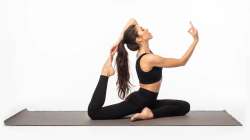5 Yoga asanas to do before bedtime for sound sleep and beat insomnia
Yoga enables a practitioner to expand their mental faculties and achieve a greater acceptance of self and others, which ultimately leads to a calmer approach to life.

Stress is the root cause of several lifestyle diseases. One of them is Insomnia. many people find it difficult to fall asleep at night even after laying in bed for hours. While this has a lot to do with what you have eaten in the day, yoga helps to beat insomnia to a great extent. Yoga adopts a scientific approach of exercising and relaxing to ease the stress of modern-day living. Yoga also contributes to improving memory, sleep and even quality of life. Here are some yoga asanas that you should try if you are suffering from restlessness at night.
'Legs Up The Wall' Pose (Viparita Karani)
Viparita Karani yogasanas are very good to heal anxiety. It relieves headaches, hypertension, sleep deprivation, breathing problems and symptoms of depression. Make sure to keep your stomach and bowels empty before you try this yoga pose. For this pose, lie on your back with a wall near you. Place your hips to the wall and raise your legs so that you are making a 90-degree angle. Lift your hips up using your hands and hold the pose for a minute while breathing normally.
Plow Pose (Halasana)
Halasana or the Plow Pose stretches your spine, shoulders and back of the legs which helps in opening the upper back and chest. It stimulates abdominal organs and calms the mind which further aids good sleep. For thsi pose, lie on your back with your arms on your sides, palms downwards. Then lift your feet off the floor using your abdominal muscles, raising your legs vertically. Do this while you inhale the air. Allow your legs to sweep in a 180-degree angle over your head till your toes touch the floor. This pose also helps women during menopause.
Child's Pose (Shishuasana)
This asana stimulates your nervous system thereby re-energizing your whole body. This asana is basically a resting pose somehow resembling a child in the fetal position. It is performed by sitting down on the knees and then bending forward so that the chest touches the thighs, and the forehead touches the ground. Stretch the arms forward. If performed with precision regularly, the performer will notice a sense of mental, physical, and emotional comfort descending upon him/her. Like most yoga asanas, this one, too, should be performed on an empty stomach or at least six hours after a meal. However, people suffering from high blood pressure and back pain should avoid this asana.
Uttanasana (Forward Bending pose)
This yoga pose is thought to be therapeutic for people suffering from high blood pressure, asthma, sinusitis, infertility and osteoporosis. It also helps to relieve mild depression and beat insomnia as it is highly beneficial as a relaxation tool. To perform this pose, stand straight. Raise your hands from the front to above your head as you inhale slowly. Bend backwards from the upper back and maintain the position with normal breathing.
Corpse Pose (Savasana)
This pose is typically performed at the end of yoga routines and helps boost mental health and relaxes the body. Lie flat on your back, keeping the body straight and hands at the sides with palms facing upwards. Close your eyes and hold the position for at least five minutes. Even pregnant women can practise this asana as it will help them prevent prenatal depression, a prevalent mental disorder in women during pregnancy.
It should be noted that the above-mentioned yogic practices are to be learned in a gradual manner under the supervision of a yoga expert. Yoga enables a practitioner to expand their mental faculties and achieve a greater acceptance of self and others, which ultimately leads to a calmer approach to life.
(With IANS inputs)